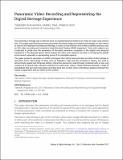Panoramic Video: Recording and Representing the Digital Heritage Experience
Author(s)
Nagakura, Takehiko; Tsai, Daniel; Choi, Joshua
DownloadPublished version (819.2Kb)
Terms of use
Metadata
Show full item recordAbstract
<jats:p>In an essay on architectural representation, Stan Allen (2000) wrote about a paradoxical nature of built forms: “Buildings are presumably more tangible and physically present than drawings, yet it is only in the experience of the building that the most intangible aspects of reality can be made visible.”Documenting a heritage site is difficult since no representational method can make an exact copy without loss. This paper specifically examines panoramic recording media and related technologies as new means to archive and represent architectural heritage. It looks at cost effective and widely available platforms such as 360 video recording, YouTube, and immersive Head Mounted Display (HMD) equipment. Tests with subjects are conducted to probe how the experience of recorded panorama compares to the spatial and temporal experience in the physical space. For instance, the subjects with HMD are tested for the ability of sensing the correct scale and proportion of spatial forms in the playback. Through analysis of the test results, discussions are made as to the roles such systems can play in conveying the spatial environment, especially in representing some of its intangible aspects.The paper shows examples of prototype designs for exhibition that utilize panoramically recorded onsite footage in derivative forms. Recordings of sites such as Palladio’s villas and the Acropolis in Athens are used to demonstrate spatial and temporal editing, interactive panoramic walk-through combined with a map, and creation of a framed-video narrative reduced from panoramic videos. These methods illustrate a range of possibilities that put each dislocated recording back into context while controlling a balance between the viewer’s exploration and the intent of the curation, and shed a light on what is often difficult to achieve by other means of representations. </jats:p>
Date issued
2017Department
Massachusetts Institute of Technology. Department of ArchitectureJournal
Studies in Digital Heritage
Publisher
IUScholarWorks